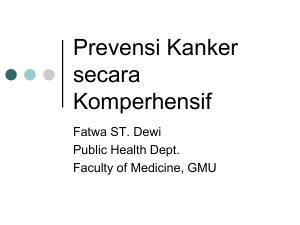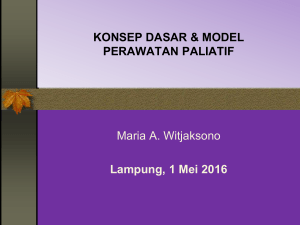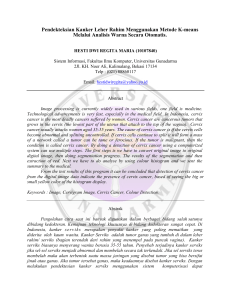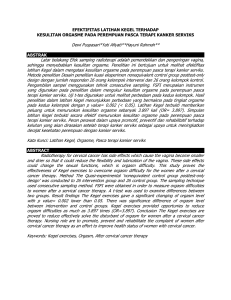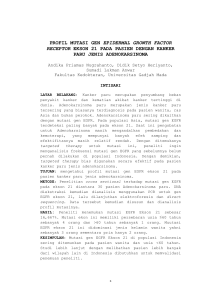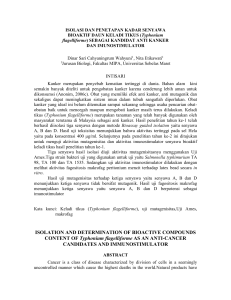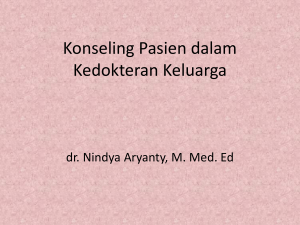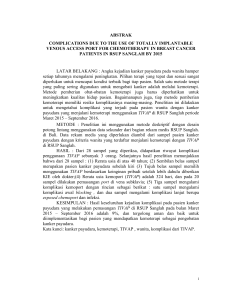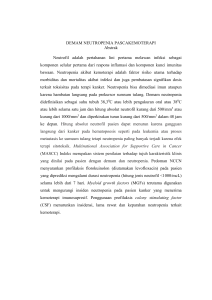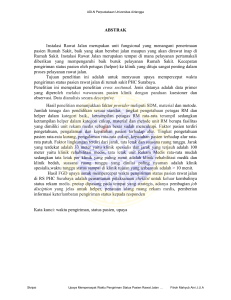Uploaded by
common.user40700
Konseling, Informed Consent: Critical Clinical Skill for Cervical Cancer Counseling
advertisement
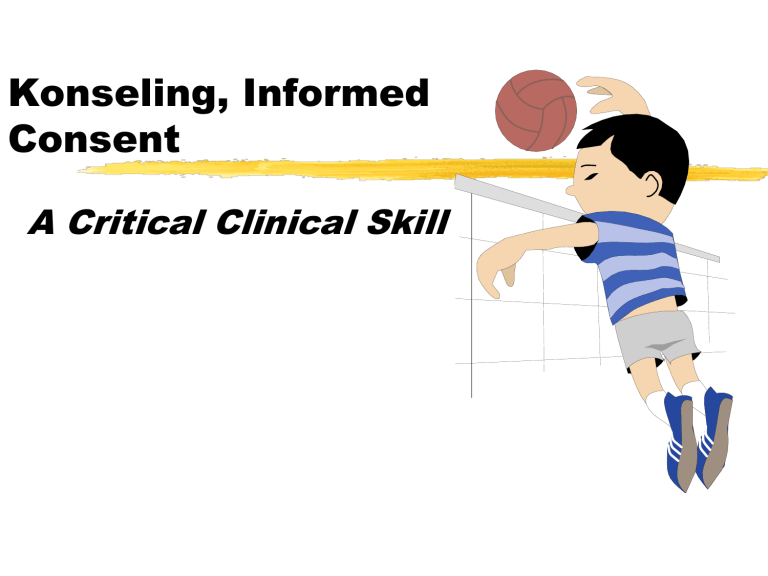
Konseling, Informed Consent A Critical Clinical Skill Tujuan pembelajaran Pada akhir sesi peserta, mampu: Menjelaskan besaran masalah kanker serviks Menjelaskan proses/tahapan terjadinya kanker serviks Menjelaskan pencegahan kanker serviks Menjelaskan hasil pemeriksaan IVA Tujuan pembelajaran Pada akhir sesi peserta, mampu: Menyampaikan berita buruk secara effektif Menjelaskan tahapan penyaampaian berita buruk dalam 6 langkah yang effektif-SPIKES Berusaha meningkatkankan kemampuan penyampaian berita buruk Menjelaskan besaran masalah kanker serviks Indonesia 1 wanita meninggal setiap jam ≥ 70% datang pada stadium lanjut Dampak sebagai istri, Ibu, lingkungan Biaya pengobatan 40-50 juta Hasil pengobatan kurang memuaskan pada stadium lanjut Menjelaskan proses/tahapan terjadinya kanker serviks Perjalanan Alamiah dari Infeksi HPV menjadi Kanker Serviks Waktu Normal epithelium Tahun Bulan HPV infection; koilocitosis CIN I Low grade squamous intraepithelial lesion (ASCUS/LSIL) CIN II High grade squamous intraepithelial lesion (HSIL) From incident to persistent HPV infection Spontaneous regression Screening Treatment CIN III Invasive Carcinoma PRIMARY SECONDARY Cervical Cancer Prevention •Vaccination (antigen) induces production of antibodies1 •Vaccination can prevent the progression of cancer-causing HPV infection to invasive cervical cancer2 •Screening can detect abnormal cells, precancerous lesions and cervical cancer however it cannot prevent HPV infection from occuring3 Vaccination alongside screening is therefore considered to offer the best protection against cervical cancer.4,5 1. IDAI: Buku Pedoman Imunisasi di Indonesia. Edisi III. Jakarta. Page 7. 2. Paavonen J et al. Lancet 2008: 369: 2161-70 3. Sankaranarayanan et al Int J Gynaecol Obstet 2005; 89 Suppl 2: S4-S12; 4. Goldie et al .J Nat Cancer Inst 2004; 111: 278–85; 5. Harper et al. Lancet 2004; 364: 1757-65. Menjelaskan hasil pemeriksaan IVA negatif Perlu pemeriksaan berkala IVA positif Tersedia sarana pengobatan Terapi dengan Krio K Konseling pasca Terapi Krio Banyak mengeluarkan cairan Mungkin ada perdarahan sedikit Bisa ada rasa kram Lama penyembuhan 4 minggu Tidak boleh berendam Tidak berhubungan badan 4 minggu Periksa ulang minggu ke 1 dan ke 4 Konseling benjolan di Payudara Konseling pasien positif Kanker serviks Kanker serviks = Berita Buruk Apa itu berita buruk ? Setiap berita yang menyebabkan persepsi kehilangan masa depan. Buckman Tujuan Membantu pasien dan keluarga memahami kondisi yang sebenarnya Dukungan pada pasien dan keluarga Meminimalisasi rasa penolakan Mengapa ini kemampuan yang penting Persepsi Pasien Bisa berefek cemas dan deppresi Membantu pasien beradaptassi dengan penyakitnya Pasien bisa mengingat berita buruk yang cukup lama Meningkatkan komunikasi HP-pasien Harapan pasien? Harapan pasien… Waktu yang cukup berkonsultasi Empati (ekspresi) Dari petugas kesehatan… Informasi lengkap, asuhan paripurna, harapan, keyakinan Ekspresi muka Strauss 1995 Jenis operasi pada Kanker Serviks • Konisasi • Histerektomi • Trachelectomy radikal • Histerektomi Radikal Angka harapan hidup 5 tahun penderita Kanker Serviks berdasarkan stadium (WHO, 1993-1995, N= 11620) Stage Mean Age Overall survival (%) HR (95% CI) Ia1 45.1 94.6 0.34 (0.24-0.46) Ia2 45.8 92.6 0.44 (0.28-0.69) Ib 48.4 80.7 Ib1 47.8 90.4 Ib2 46.2 79.8 IIa 54.0 76.0 1.85 (1.57-2.18) IIb 53.3 73.3 2.05 (1.82-2.30) IIIa 62.1 50.5 3.31 (2.52-4.36) IIIb 56.2 46.4 4.70 ( 4.20-5.25) IVa 57.7 29.6 7.81 ( 6.46-9.44) IVb 57.3 22.0 11.23 (9.22-13.69) J Epid Biostat (2001) Vol 6 No. 1 Reference 4/4/2008 MFA 19 S etting up the interview P erception of the patient re their illness I nvitation from patient to share info K nowledge and Information conveyed E motions responded to empathically S ummary and Strategy for follow-up 1. Setting up the interview Penyampaian pasca selesai IVA atau selesai hasil biopsi Matikan telepon Privacy, posisi duduk Tidak memotong pembicaraan Ensure adequate time 1. Setting up the interview Lab reports, X-rays present Support person present , if desired Review the condition, basic prognosis and treatments before the visit HOPEFUL TONE Assessing the patient’s 2. Perception ASK then TELL Important if the patient is not well known to you OR if visits to consultants have occurred “Assess the Gap” between what the patient knows and the diagnosis “What have you already been told about might be going on? “What is your understanding of why the CT scan was ordered?” Obtaining the patient’s 3. Invitation Preferably before the visit Easier if patient is well- known Listen to patient cues “Are you the sort of person who likes to know all the details of your condition? “Would you like me to discuss the results of the CT scan with you?” Giving 4. Knowledge and Information Align yourself with the patient’s understanding and vocabulary Start with a warning shot: “I’m afraid that the scan shows that the problem is fairly serious.” Give diagnosis simply, avoid euphemisms or excessive bluntness Provide information in small chunks Check frequently for understanding Giving 4. Knowledge and Information Check for knowledge or experience with condition Allow for pauses, use repetition Will usually want basic but clear information re treatment plan and prognosis BUT Tune into patient readiness to hear more, and know when to stop Balancing Truth and Hope: The Skillful Use of Indirect Language S Healing et al 2006 “It looks like….” not “You have….” “there are tumours in the liver…” not “you have tumours in your liver…” Emphasize on maintaining the relationship as well as communicating the news Respond to 5. Emotions empathically Observe for and allow emotional reactions Kleenex handy, use of touch N aming the feeling “I know this is upsetting” U nderstanding “It would be for anyone” R especting “You’re asking all the right questions” S upporting “I’ll do everything I can to help you through this.” 6. Summary and Strategy for follow-up Summarize discussion Clear follow-up plan re: referral, tests, next contact (in <48 hrs) Provide written summary or brochures Refer to community resources Invite support person for next visit if not present 6. Summary and Strategy for follow-up End on note of hope and partnership AFTER: document well assess your own reaction Six Steps for Breaking Bad News S etting up the interview P erception of the patient re their illness I nvitation from patient to share info K nowledge and Information conveyed E motions responded to empathically S ummary and Strategy for follow-up Discrepancies in Ratings Patients rated the following much higher than doctor and nurses: receiving bad news in a quiet, private place arranging a follow-up visit soon to review with patient and family inform patient about support services Girgis, Behavioural Medicine 1999 Follow-up Please take a handout outlining the SPIKES steps in sharing bad news Try out one or two of the suggestions next time you have bad news to share “The task of breaking bad news is a testing ground for the entire range of our professional skills and abilities. If we do it badly, the patients or family members may never forgive us; if we do it well, they will never forget us.” Robert Buckman Thank you!
